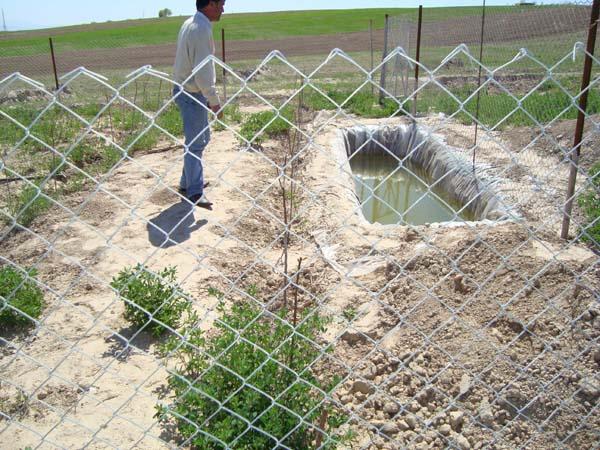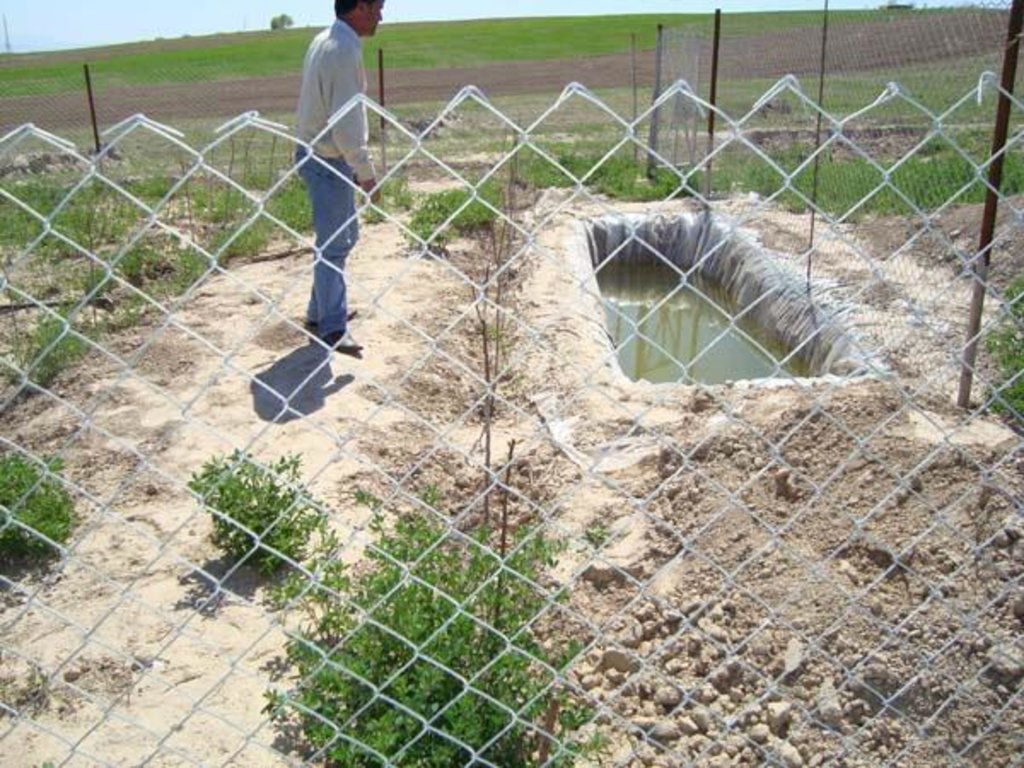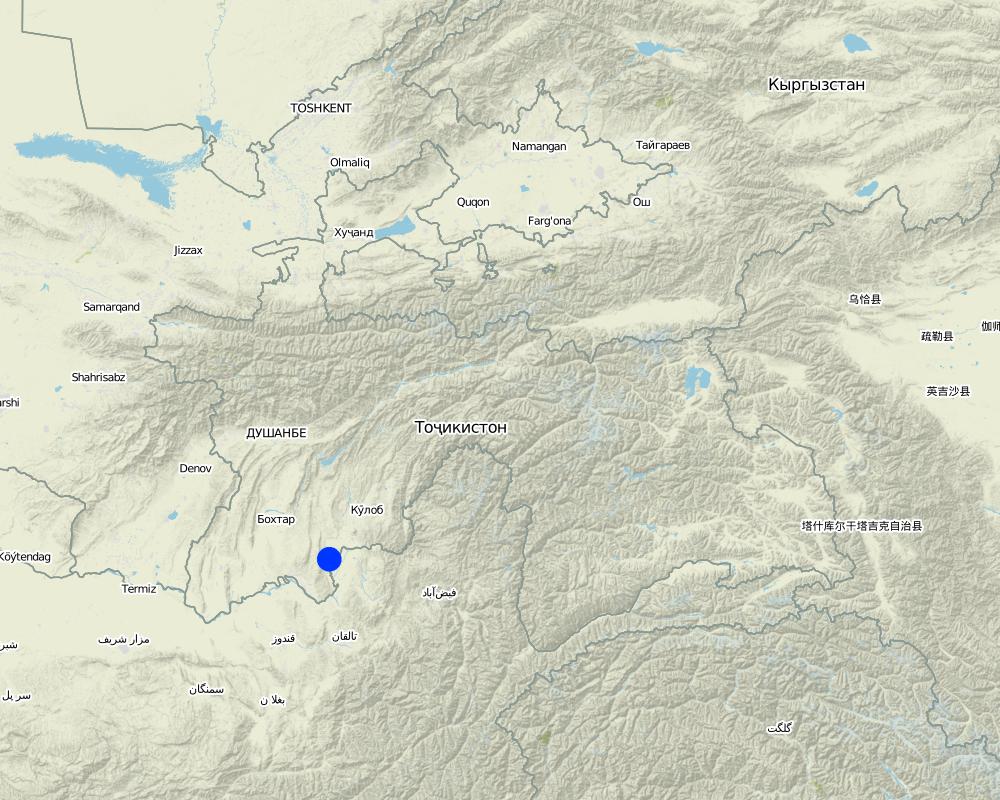Terracing on the hill slope areas [Tajikistan]
- Creation:
- Update:
- Compiler: Rustam Nugmanov
- Editor: –
- Reviewers: David Streiff, Alexandra Gavilano
Planting of fruit trees on terraced slope in rain fed areas with a perimeter fence
technologies_1033 - Tajikistan
View sections
Expand all Collapse all1. General information
1.2 Contact details of resource persons and institutions involved in the assessment and documentation of the Technology
Name of the institution(s) which facilitated the documentation/ evaluation of the Technology (if relevant)
Agency for Technical Cooperation and Development Tajikistan (ACTED Tajikistan) - Tajikistan1.3 Conditions regarding the use of data documented through WOCAT
The compiler and key resource person(s) accept the conditions regarding the use of data documented through WOCAT:
Yes
2. Description of the SLM Technology
2.1 Short description of the Technology
Definition of the Technology:
Planting of trees and bushes in the rain fed slope areas by using mulching, rain water harvesting and organic fertilizers
2.2 Detailed description of the Technology
Description:
6 vulnerable households are selected to carry out this pilot activity. They maintain terraced plots of 0.01 ha (10m x 10m) each. Households fence the entire area to protect it against animals. The plots are constructed on the slope of a hill by digging terraces/steps with intervals of 1m. 10 fruit seedlings are planted along one row and 10 rows are planted in total. In some areas where there is a probem with watering of new seedlings simple basin covered with plastic sheet could be installed in order to harvest rain water for the purpose of irrigation of seedling in ht summer periods or when there is a lack of water
Purpose of the Technology: The terracing will help to mitigate wind erosion by preventing top soil losses. The terraces will also provide protection against water erosion by catching water and improving natural infiltration of water. The terraced plot also provides an economic benefit to land users by functioning as an orchard.
Establishment / maintenance activities and inputs: The criteria for the establishment of the plots are the local conditions: this takes into account the sensitivity of the land to erosion, that the land is rainfed, and the vulnerability of households in or near the potential target areas/slopes. If the criteria are met, households then establish a fenced area of 0.01 ha in the target slope/area. They receive the task of planting and maintaining the orchard plots by watering (if necessary), pruning, mulching, and using organic fertilizers.
Natural / human environment: The issue with the target area/slopes is that they suffer from water or wind erosion. Therefore, they require terraced plots to mitigate the effects of erosion. In terms of human influence, the lands have either been overgrazed and were unproductive for vulnerable households in the area.
2.3 Photos of the Technology
2.5 Country/ region/ locations where the Technology has been applied and which are covered by this assessment
Country:
Tajikistan
Region/ State/ Province:
Khatlon province
Further specification of location:
Farkhor district
Specify the spread of the Technology:
- evenly spread over an area
Comments:
Total area covered by the SLM Technology is 0.0006 km2.
6 demoplots established in 6 different jamoats of Farkhor district, each demonstration plot area is 0.01 ha.
Map
×2.6 Date of implementation
If precise year is not known, indicate approximate date:
- more than 50 years ago (traditional)
2.7 Introduction of the Technology
Specify how the Technology was introduced:
- through projects/ external interventions
Comments (type of project, etc.):
This technology has been in use since the 1940ies / 50ies. It is mainly used by the local population in rural areas.
3. Classification of the SLM Technology
3.1 Main purpose(s) of the Technology
- reduce, prevent, restore land degradation
3.2 Current land use type(s) where the Technology is applied
Land use mixed within the same land unit:
Yes
Specify mixed land use (crops/ grazing/ trees):
- Agroforestry

Cropland
- Tree and shrub cropping
Tree and shrub cropping - Specify crops:
- pome fruits (apples, pears, quinces, etc.)
- stone fruits (peach, apricot, cherry, plum, etc)
- tree nuts (brazil nuts, pistachio, walnuts, almonds, etc.)
Number of growing seasons per year:
- 1
Specify:
Longest growing period in days: 120; Longest growing period from month to month: February-May

Grazing land

Forest/ woodlands
Type of tree:
- Acacia albida
- shrubs
Comments:
Major land use problems (compiler’s opinion): water insufficiency for irrigation purposes
Major land use problems (land users’ perception): water insufficiency, especially in summer period
Future (final) land use (after implementation of SLM Technology): Mixed: Mf: Agroforestry
3.3 Has land use changed due to the implementation of the Technology?

Grazing land
Comments:
Grazing land: Ge: Extensive grazing land
3.4 Water supply
Water supply for the land on which the Technology is applied:
- rainfed
3.5 SLM group to which the Technology belongs
- cross-slope measure
- water harvesting
3.6 SLM measures comprising the Technology

vegetative measures
- V1: Tree and shrub cover

structural measures
- S1: Terraces
Comments:
Type of vegetative measures: aligned: -linear
3.7 Main types of land degradation addressed by the Technology

soil erosion by water
- Wt: loss of topsoil/ surface erosion

biological degradation
- Bc: reduction of vegetation cover
Comments:
Main causes of degradation: deforestation / removal of natural vegetation (incl. forest fires) (Cutting of trees by people), other human induced causes (specify) (Cutting of forests for wood), change of seasonal rainfall (Insufficient rainfalls), population pressure (overgrazing of animals on the same area)
Secondary causes of degradation: overgrazing
3.8 Prevention, reduction, or restoration of land degradation
Specify the goal of the Technology with regard to land degradation:
- restore/ rehabilitate severely degraded land
4. Technical specifications, implementation activities, inputs, and costs
4.1 Technical drawing of the Technology
Technical specifications (related to technical drawing):
The plots are constructed on the slope of a hill by digging terraces/steps with intervals of 1m. 10 fruit seedlings are planted along one row and 10 rows are planted in total. In some areas where there is a probem with watering of new seedlings simple basin covered with plastic sheet could be installed in order to harvest rain water for the purpose of irrigation of seedling in ht summer periods or when there is a lack of water. Beside this all plots are surrounded with metalic fence in order to avoid animals from damaging the new palnted seedlings
Farkhor district
Date: 20.12.2011
Technical knowledge required for field staff / advisors: moderate
Technical knowledge required for land users: moderate
Main technical functions: increase / maintain water stored in soil
Secondary technical functions: control of concentrated runoff: drain / divert, reduction of slope angle, improvement of ground cover, improvement of water quality, buffering / filtering water, reduction in wind speed
Aligned: -along boundary
Vegetative material: T : trees / shrubs
Aligned: -linear
Vegetative material: T : trees / shrubs
Number of plants per (ha): 7500
Vertical interval between rows / strips / blocks (m): 2
Spacing between rows / strips / blocks (m): 1
Vertical interval within rows / strips / blocks (m): 1
Width within rows / strips / blocks (m): 1
Trees/ shrubs species: acacia, shrubs
Fruit trees / shrubs species: apple, almond trees, apricot trees, cherry trees, quince trees
Slope (which determines the spacing indicated above): 45%
If the original slope has changed as a result of the Technology, the slope today is (see figure below): 45%
Gradient along the rows / strips: 40%
Terrace: backward sloping
Vertical interval between structures (m): 2
Spacing between structures (m): 1
Depth of ditches/pits/dams (m): 0.4
Width of ditches/pits/dams (m): 0.4
Length of ditches/pits/dams (m): 10
Construction material (other): metal lath and pipes for the poles (stand)
Slope (which determines the spacing indicated above): 45%
If the original slope has changed as a result of the Technology, the slope today is: 45%
Lateral gradient along the structure: 45%
For water harvesting: the ratio between the area where the harvested water is applied and the total area from which water is collected is: 1:0,06
Vegetation is used for stabilisation of structures.
4.2 General information regarding the calculation of inputs and costs
Specify how costs and inputs were calculated:
- per Technology unit
Specify unit:
Garden
Specify dimensions of unit (if relevant):
500 trees
other/ national currency (specify):
somoni
If relevant, indicate exchange rate from USD to local currency (e.g. 1 USD = 79.9 Brazilian Real): 1 USD =:
2.46
Indicate average wage cost of hired labour per day:
25
4.3 Establishment activities
| Activity | Timing (season) | |
|---|---|---|
| 1. | digging of the holes | in the early spring |
| 2. | planting of trees | in the early spring |
| 3. | Terracing of slope areas | in the early spring |
| 4. | Fencing of the area | during planting of the trees |
| 5. | Digging of water harvesting basin | while esteblishing of terraces |
4.4 Costs and inputs needed for establishment
| Specify input | Unit | Quantity | Costs per Unit | Total costs per input | % of costs borne by land users | |
|---|---|---|---|---|---|---|
| Labour | Digging of the holes | persons/day/unit | 1.0 | 25.0 | 25.0 | |
| Labour | Planting of trees | persons/day/unit | 5.0 | 25.0 | 125.0 | 73.0 |
| Labour | Terracing of slope areas | persons/day | 2.0 | 25.0 | 50.0 | 100.0 |
| Labour | Digging of water harvesting basin | person/basin | 1.0 | 30.0 | 30.0 | 100.0 |
| Construction material | Fencing of area | unit | 1.0 | 600.0 | 600.0 | |
| Total costs for establishment of the Technology | 830.0 | |||||
| Total costs for establishment of the Technology in USD | 337.4 | |||||
4.5 Maintenance/ recurrent activities
| Activity | Timing/ frequency | |
|---|---|---|
| 1. | watering the plants | 2 times per week |
| 2. | Mulching the new plants | when it is necessary |
| 3. | using of organic fertilizers for trees | During the planting and after couple of months |
| 4. | rain water harvesting near the kitchen gardens for watering of new trees | when available |
| 5. | Supervision and observing | on constant base |
4.6 Costs and inputs needed for maintenance/ recurrent activities (per year)
| Specify input | Unit | Quantity | Costs per Unit | Total costs per input | % of costs borne by land users | |
|---|---|---|---|---|---|---|
| Labour | Watering the plants | persons/day | 1.0 | 20.0 | 20.0 | 100.0 |
| Labour | Mulching the new plants | persons/day | 1.0 | 20.0 | 20.0 | 100.0 |
| Labour | Using of organic fertilizers for trees | persons/day | 1.0 | 20.0 | 20.0 | 100.0 |
| Labour | Rain water harvesting near the kitchen gardens for watering of new trees | persons/day | 1.0 | 25.0 | 25.0 | 100.0 |
| Fertilizers and biocides | Fertilizer | kg/unit | 1000.0 | 1.0 | 1000.0 | 100.0 |
| Total costs for maintenance of the Technology | 1085.0 | |||||
| Total costs for maintenance of the Technology in USD | 441.06 | |||||
Comments:
Machinery/ tools: spade, pail, chopper
area used for the technology: fenced plot of 0.01 ha
4.7 Most important factors affecting the costs
Describe the most determinate factors affecting the costs:
Soil structure, slope
5. Natural and human environment
5.1 Climate
Annual rainfall
- < 250 mm
- 251-500 mm
- 501-750 mm
- 751-1,000 mm
- 1,001-1,500 mm
- 1,501-2,000 mm
- 2,001-3,000 mm
- 3,001-4,000 mm
- > 4,000 mm
Specifications/ comments on rainfall:
Mostly in winter and spring period. Dry periods starts from the end of spring till September, October
Agro-climatic zone
- sub-humid
- semi-arid
Thermal climate class: temperate
5.2 Topography
Slopes on average:
- flat (0-2%)
- gentle (3-5%)
- moderate (6-10%)
- rolling (11-15%)
- hilly (16-30%)
- steep (31-60%)
- very steep (>60%)
Landforms:
- plateau/plains
- ridges
- mountain slopes
- hill slopes
- footslopes
- valley floors
Altitudinal zone:
- 0-100 m a.s.l.
- 101-500 m a.s.l.
- 501-1,000 m a.s.l.
- 1,001-1,500 m a.s.l.
- 1,501-2,000 m a.s.l.
- 2,001-2,500 m a.s.l.
- 2,501-3,000 m a.s.l.
- 3,001-4,000 m a.s.l.
- > 4,000 m a.s.l.
Comments and further specifications on topography:
Soil fertility is low
Soil drainage / infiltration is poor and one of the main reasons of gully forming
Soil water storage capacity is low during dry seasonal periods
5.3 Soils
Soil depth on average:
- very shallow (0-20 cm)
- shallow (21-50 cm)
- moderately deep (51-80 cm)
- deep (81-120 cm)
- very deep (> 120 cm)
Soil texture (topsoil):
- medium (loamy, silty)
Topsoil organic matter:
- medium (1-3%)
5.4 Water availability and quality
Availability of surface water:
medium
Water quality (untreated):
poor drinking water (treatment required)
Comments and further specifications on water quality and quantity:
Water quality (untreated): Mostly hand water pumps
5.5 Biodiversity
Species diversity:
- medium
5.6 Characteristics of land users applying the Technology
Off-farm income:
- 10-50% of all income
Relative level of wealth:
- poor
Individuals or groups:
- individual/ household
Gender:
- women
- men
Indicate other relevant characteristics of the land users:
Land users applying the Technology are mainly common / average land users
Annual population growth: 2% - 3%
5.7 Average area of land used by land users applying the Technology
- < 0.5 ha
- 0.5-1 ha
- 1-2 ha
- 2-5 ha
- 5-15 ha
- 15-50 ha
- 50-100 ha
- 100-500 ha
- 500-1,000 ha
- 1,000-10,000 ha
- > 10,000 ha
Is this considered small-, medium- or large-scale (referring to local context)?
- small-scale
5.8 Land ownership, land use rights, and water use rights
Land ownership:
- communal/ village
Land use rights:
- leased
5.9 Access to services and infrastructure
health:
- poor
- moderate
- good
education:
- poor
- moderate
- good
technical assistance:
- poor
- moderate
- good
employment (e.g. off-farm):
- poor
- moderate
- good
markets:
- poor
- moderate
- good
energy:
- poor
- moderate
- good
roads and transport:
- poor
- moderate
- good
drinking water and sanitation:
- poor
- moderate
- good
financial services:
- poor
- moderate
- good
6. Impacts and concluding statements
6.1 On-site impacts the Technology has shown
Socio-economic impacts
Production
crop production
fodder production
fodder quality
wood production
Water availability and quality
demand for irrigation water
Socio-cultural impacts
cultural opportunities
livelihood and human well-being
Comments/ specify:
Behavioral change, people got information on the advantages of applying organic fertilizers and water harvesting to develop their plots on rainfed lands
Ecological impacts
Water cycle/ runoff
surface runoff
evaporation
Soil
soil moisture
soil cover
salinity
Biodiversity: vegetation, animals
plant diversity
Climate and disaster risk reduction
wind velocity
6.2 Off-site impacts the Technology has shown
damage on neighbours' fields
6.3 Exposure and sensitivity of the Technology to gradual climate change and climate-related extremes/ disasters (as perceived by land users)
Gradual climate change
Gradual climate change
| Season | increase or decrease | How does the Technology cope with it? | |
|---|---|---|---|
| annual temperature | increase | not well |
Climate-related extremes (disasters)
Meteorological disasters
| How does the Technology cope with it? | |
|---|---|
| local rainstorm | not well |
| local windstorm | well |
Climatological disasters
| How does the Technology cope with it? | |
|---|---|
| drought | not well |
Hydrological disasters
| How does the Technology cope with it? | |
|---|---|
| general (river) flood | well |
Other climate-related consequences
Other climate-related consequences
| How does the Technology cope with it? | |
|---|---|
| reduced growing period | well |
Comments:
main damage may be caused by droughts, thus plants will feel water insufficiency
6.4 Cost-benefit analysis
How do the benefits compare with the establishment costs (from land users’ perspective)?
Short-term returns:
positive
Long-term returns:
very positive
How do the benefits compare with the maintenance/ recurrent costs (from land users' perspective)?
Short-term returns:
positive
Long-term returns:
very positive
Comments:
Establishment of plots with terracing on slope areas does not demand lots of funding and planting of fruit trees will become a source of alternative income in the near future
6.5 Adoption of the Technology
- single cases/ experimental
Of all those who have adopted the Technology, how many did so spontaneously, i.e. without receiving any material incentives/ payments?
- 0-10%
Comments:
There is a moderate trend towards spontaneous adoption of the Technology
6.7 Strengths/ advantages/ opportunities of the Technology
| Strengths/ advantages/ opportunities in the compiler’s or other key resource person’s view |
|---|
| The technology is user-friendly and does not require complicated tools or agro-inputs. Land users can replicate this technology with minimal cost. |
6.8 Weaknesses/ disadvantages/ risks of the Technology and ways of overcoming them
| Weaknesses/ disadvantages/ risks in the compiler’s or other key resource person’s view | How can they be overcome? |
|---|---|
| It does rely on climactic conditions. If there is an extended period of dry weather this can have a detrimental effect on the tree seedlings. | By ensuring that land users maintain these plots by regularly watering them and using mulching. |
7. References and links
7.1 Methods/ sources of information
- field visits, field surveys
- interviews with land users
When were the data compiled (in the field)?
03/05/2011
Links and modules
Expand all Collapse allLinks
No links
Modules
No modules




